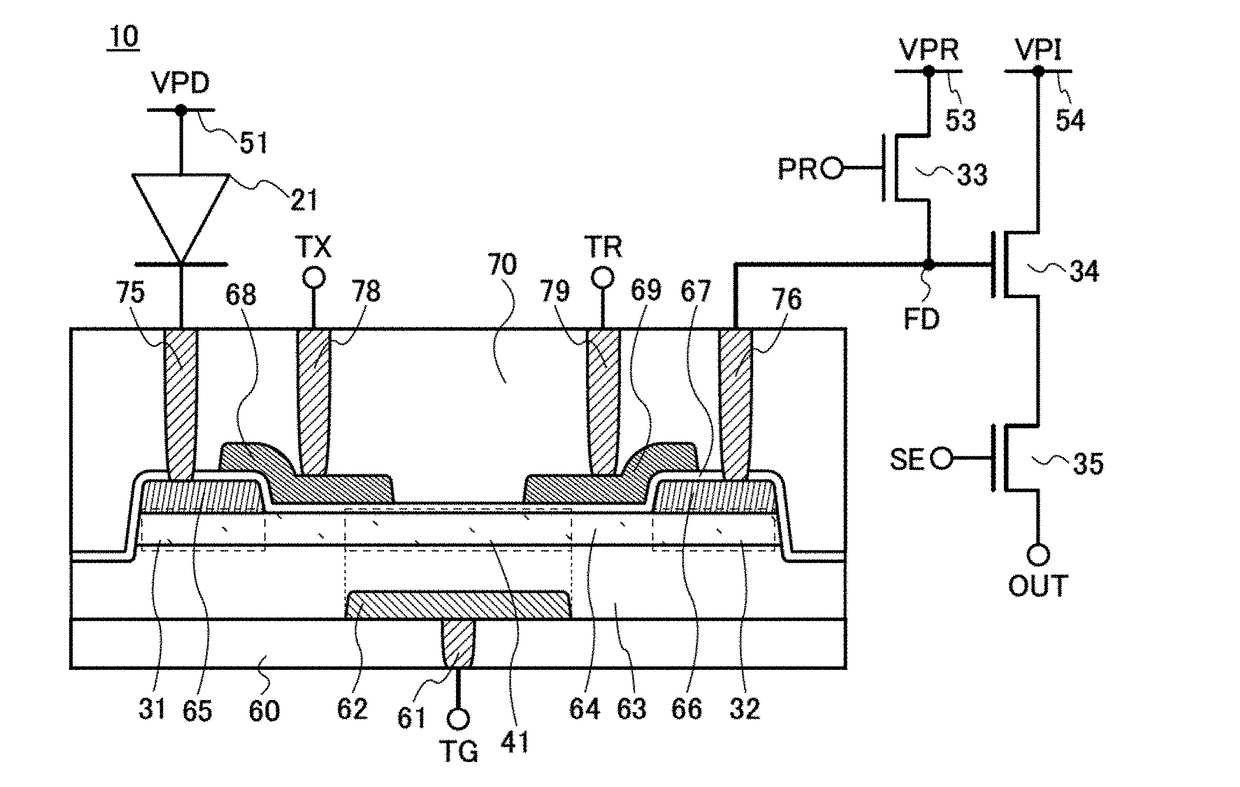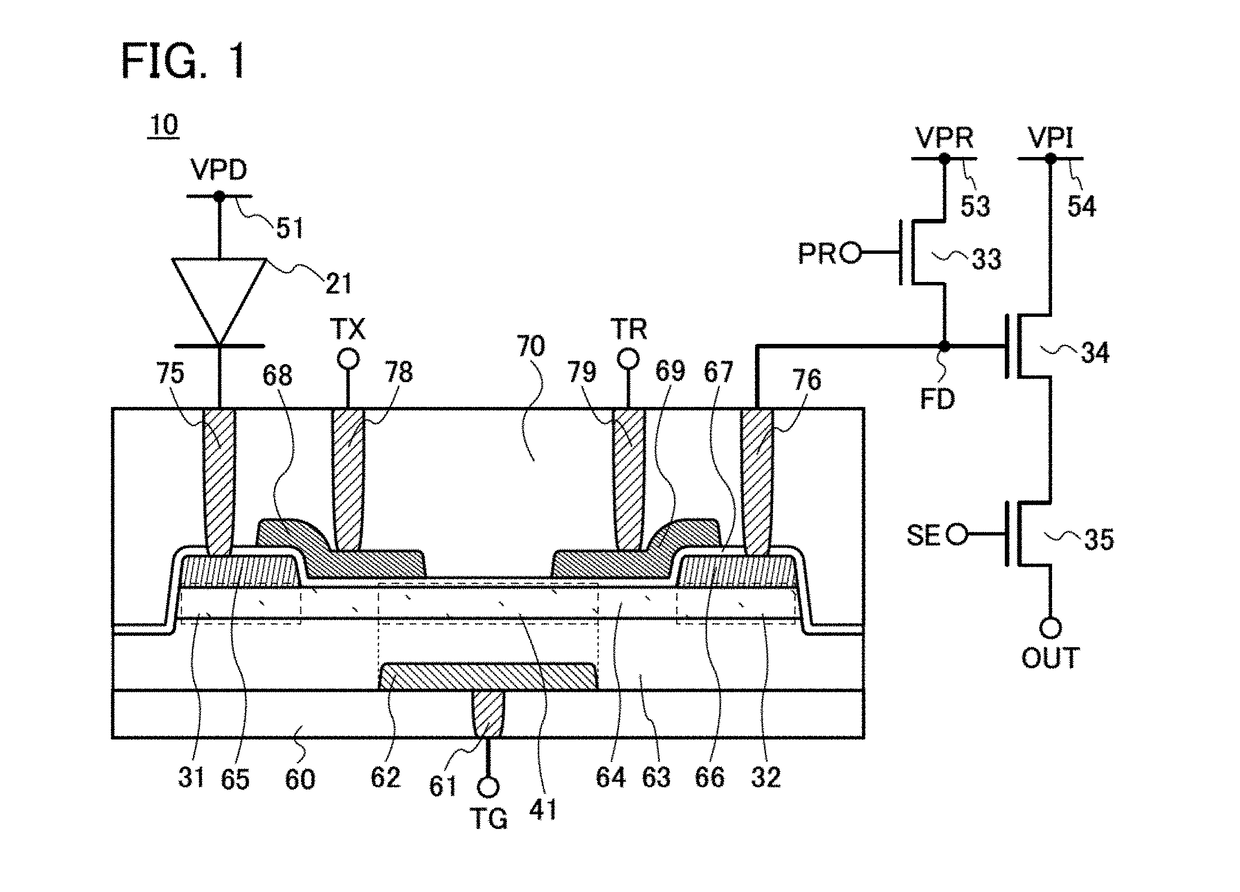Imaging device, module, and electronic device
- Summary
- Abstract
- Description
- Claims
- Application Information
AI Technical Summary
Benefits of technology
Problems solved by technology
Method used
Image
Examples
embodiment 1
[0080]In this embodiment, an imaging device that is one embodiment of the present invention will be described with reference to drawings.
[0081]FIG. 1 illustrates a cross-sectional view and a circuit diagram that show a structure example of a pixel 10 included in an imaging device of one embodiment of the present invention. Although FIG. 1 and the like show an example using n-channel transistors, one embodiment of the present invention is not limited to this, and some transistors may be replaced with p-channel transistors.
[0082]The pixel 10 includes a conductor 62 in contact with an insulator 60; an insulator 63 in contact with the conductor 62; a semiconductor 64 in contact with the insulator 63; a conductor 65 and a conductor 66 in contact with the semiconductor 64; an insulator 67 in contact with the insulator 63, the semiconductor 64, and the conductors 65 and 66; a conductor 68 and a conductor 69 in contact with the insulator 67; and an insulator 70 in contact with the insulator...
embodiment 2
[0227]In this embodiment, an OS transistor that can be used in one embodiment of the present invention will be described with reference to drawings. In the drawings in this embodiment, some components are enlarged, reduced in size, or omitted for easy understanding.
[0228]FIGS. 22A to 22C are a top view and cross-sectional views of a transistor 301 of one embodiment of the present invention. FIG. 22A is the top view. FIG. 22B shows a cross section along the dashed-dotted line X1-X2 in FIG. 22A. FIG. 22C shows a cross section along the dashed-dotted line Y1-Y2 in FIG. 22A.
[0229]In the drawings explained in this embodiment, the direction of the dashed-dotted line X1-X2 is referred to as channel length direction, and the direction of the dashed-dotted line Y1-Y2 is referred to as channel width direction.
[0230]The transistor 301 includes a conductor 320 in contact with the substrate 310, an insulator 330 in contact with the substrate 310 and the conductor 320, an oxide semiconductor 340 ...
embodiment 3
[0274]In this embodiment, components of the transistors shown in Embodiment 2 will be described in detail.
[0275]As the substrate 310, a glass substrate, a quartz substrate, a semiconductor substrate, a ceramic substrate, a metal substrate with an insulated surface, or the like can be used. Other examples are a silicon substrate provided with a transistor and / or a photodiode; and a silicon substrate over which an insulator, a wiring, a conductor functioning as a contact plug, and the like are provided together with a transistor and / or a photodiode. When a p-channel transistor is formed on a silicon substrate, a silicon substrate with n−-type conductivity is preferably used. Alternatively, an SOI substrate including an n−-type or i-type silicon layer may be used. Moreover, when a p-channel transistor is formed on a silicon substrate, a surface of the silicon substrate where the transistor is formed preferably has a (110) plane orientation, in which case the mobility can be increased.
[...
PUM
 Login to View More
Login to View More Abstract
Description
Claims
Application Information
 Login to View More
Login to View More - Generate Ideas
- Intellectual Property
- Life Sciences
- Materials
- Tech Scout
- Unparalleled Data Quality
- Higher Quality Content
- 60% Fewer Hallucinations
Browse by: Latest US Patents, China's latest patents, Technical Efficacy Thesaurus, Application Domain, Technology Topic, Popular Technical Reports.
© 2025 PatSnap. All rights reserved.Legal|Privacy policy|Modern Slavery Act Transparency Statement|Sitemap|About US| Contact US: help@patsnap.com



